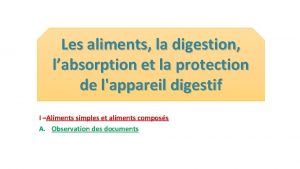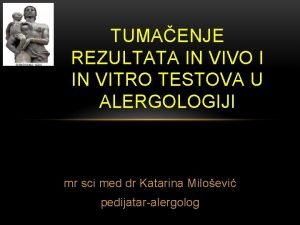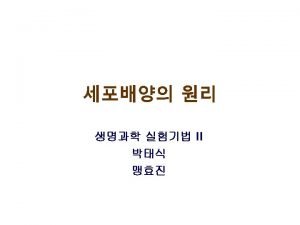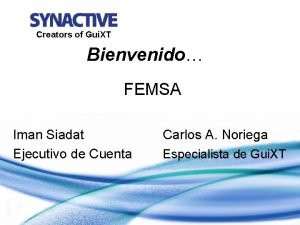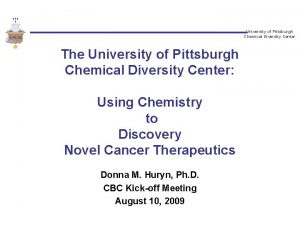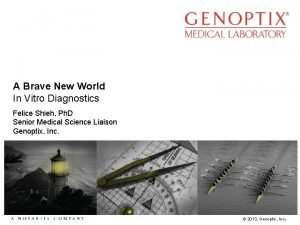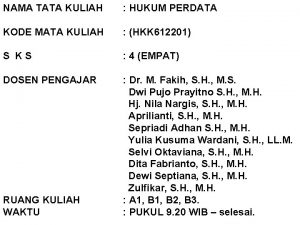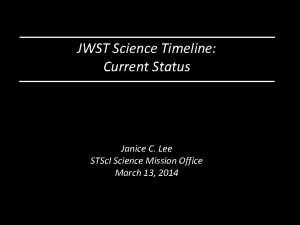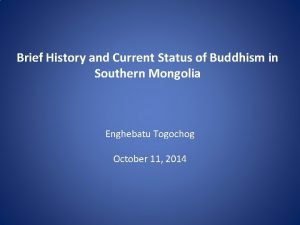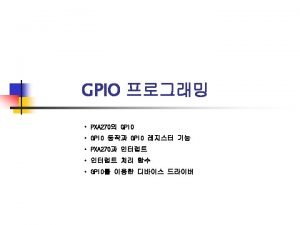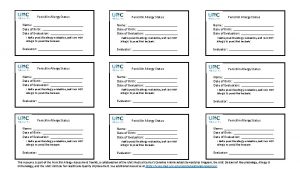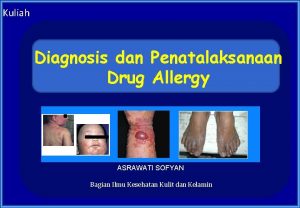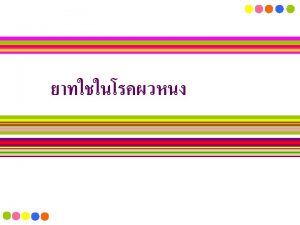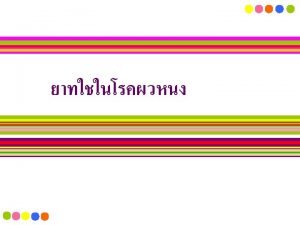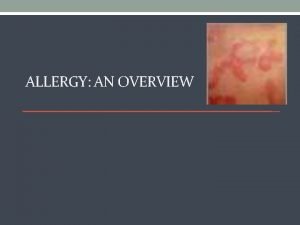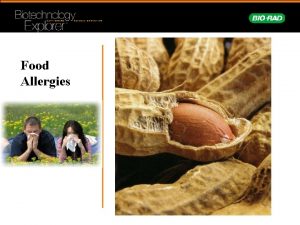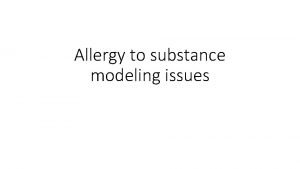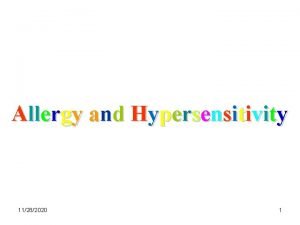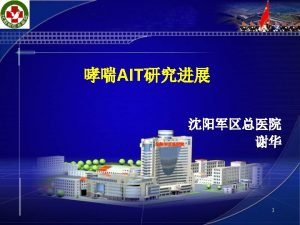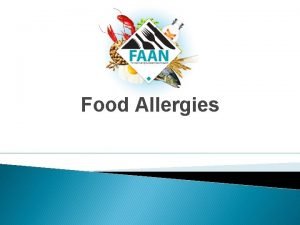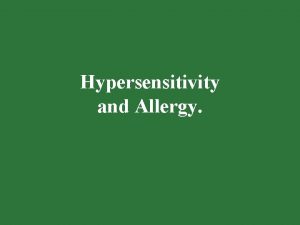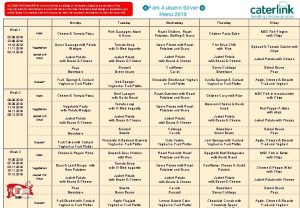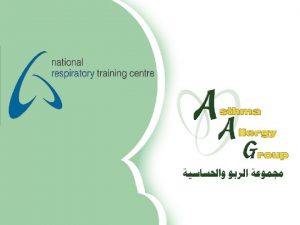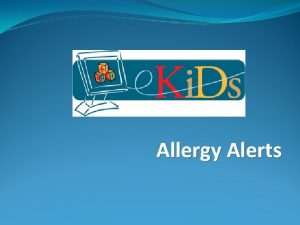In vitro Diagnosis of Drug Allergy Current Status




























- Slides: 28

In vitro Diagnosis of Drug Allergy: Current Status and Perspectives Thomas A. Fleisher, M. D. , FAAAAI, FACAAI National Institutes of Health Bethesda, MD, USA

Dr. Fleisher has no conflicts of interest related to this presentation

Drugs as Immunogens • Biologics: foreign macromolecules (e. g. antibodies, recombinant proteins) act directly as immunogen • Drugs (non-biologics) – Hapten – drug (e. g. b-lactam antibiotics, quinidine) combines with a host macromolecule – Pro-hapten – processed drug (e. g. sulfonamides, phenytoin) combines with a host macromolecule • Drugs can act directly to stimulate an immune receptor (pharmacologic interaction with immune receptors = p-i concept)

Use of in vitro Testing for Drug Allergy • Testing in the setting of an immediate drug reaction • Testing in the setting of a delayed drug reaction • Testing on the horizon

Immediate Reaction to Drug • Gell and Coombs type 1 reaction that occurs rapidly upon exposure to a specific drug • Standard approach to evaluate is immediate skin testing (penicillin major and minor determinants are validated, other drugs ? ) • In vitro methods of evaluation include: – Tryptase to establish mast cell degranulation – Allergen (drug) specific Ig. E testing – Basophil activation test (BAT)

Tryptase Testing • Mature tryptase reflects mast cell degranulation and is elevated in a systemic allergic reaction • Current laboratory test most widely available measure total tryptase (not mature tryptase) – Released within 30 -60 minutes following activation and half life is ~2 hours allows longer “testing window” – Levels above normal range (vary among labs: 10 -11. 4 ng/m. L) are consistent with anaphylaxis (or increased mast cell numbers) but the sensitivity is not high – More sensitive test for anaphylaxis: mature tryptase level or a total tryptase rise over baseline of > 2 ng/m. L

Allergen Specific Ig. E Testing • In vitro “equivalent” of immediate skin testing • Does not subject patient to risk and does not have a potential of inducing sensitization • Limited range of drugs available impacts utility: b-lactams (penicilloyl G & V, ampicilloyl, amoxocilloyl), ACTH, cefator, ceftriazone, chlorhexidene, ethylene oxide, gelatin, insulin, neuromuscular blocking agents, tetanus toxoid) • Tests generally have high specificity with lower sensitivity - negative test does not rule out allergy

Basophil Activation Test • Test evaluates basophils present in either whole blood or separated mononuclear cells • Validated for aeroallergens, hymenoptera venoms, foods, latex, some drugs (generally based on a generated drug-protein complex) • Commercial assay (not FDA approved in USA): uses expression of CCR 3 to identify basophils and expression of CD 63 to identify activation after incubating cells the with drug complex • “Enhanced assay” adds a third marker, CD 203 c

Basophil Activation Test Gating “lymphocytes” Drug-HSA Steiner, M. et al. J Vis Exp 2011 Gating basophils Negative control Positive control: 52. 5% CD 63+, SI - 5501/386 = 14. 2 Positive drug BAT: 20. 6% CD 63+; SI - 1893/386 = 4. 9

Basophil Activation Test • Advantages – – Does not subject patient to any risks Functional test that resembles the in vivo pathway Relatively good sensitivity with high specificity Positive BAT depends on type of allergen • Aeroallergens/foods >15% CD 63+ basophils • Venoms >10% CD 63+ basophils • Drugs (b-lactams, analgesics) >5% CD 63+ basophils • Disadvantages – Must have viable, non-activated cells (24 hr “window”) – More limited availability since it requires a flow cytometer and generation of drug-protein (hapten-carrier) complex – Negative test does not rule out drug allergy

BAT in Radiocontrast Media Reactions • Evaluation of 26 patients with history of immediate radiocontrast media (RCM) reactions: BAT using five different RCM products (tested months later) • BAT results: 15/26 patients had a positive BAT – 1: 100 RCM: – 1: 10 RCM: patients = 13. 1% CD 63+/SI=8. 1 (p=0. 01) controls = 2. 7% CD 63+/SI=1. 5 patients = 19. 2% CD 63+/SI=9. 0 (p=0. 001) controls = 3. 7% CD 63+/SI=2. 3 • Receiver Operator Curve (ROC) area under the curve was 0. 79 = test with moderate accuracy Pinnobphun P, et al. Ann Allergy Asthma Immunol 2011, 106: 387

Delayed Immunologic Reaction to Drugs • Most commonly linked to cellular response (Gell and Coombs Type IV reaction involving T cells) • These reactions have been subdivided into – Type IVa: mediated by Th 1 response – Type IVb: mediated by Th 2 response – Type IVc: mediated by cytotoxic cell response – Type IVd: mediated by neutrophilic inflammation • Additional data now suggests that some reactions involve conventional Tc. R activation (e. g. where there is an HLA link) and others involve direct drug-immune receptor interaction (p-i concept)

Focus of in vitro Testing • Confirm that the clinical findings are the result of an immunologic response (rather than a pharmacologic or idiosyncratic response) • Identify the causative drug in settings where multiple drugs have been administered • Current testing methods – Lymphocyte transformation test (LTT) – CD 69 upregulation flow cytometry test – Cytokine production – Evaluation of cytotoxicity (or its products)

Lymphocyte Transformation Test (LTT) I- Activation in vitro Varied concentrations of pure drug, incubate at 37ºC with 5% CO 2 PBMC Peripheral blood mononuclear cells (PBMC) 6 days PBMC Cells Add 3 H thymidine II- Quantify Response T cell Harvest cells and count radioactivity, results: cpm or stimulation index (SI = drug stimulated cpm/unstimulated cpm)

Lymphocyte Transformation Test (LTT) • Must use controls to establish lack of drug induced toxicity and to rule out non-specific activation • Must have viable cells and requires sterile tissue culture • LTT has been successfully applied to drug associated: – – Maculopapular exanthem Pustular exanthem Stevens Johnson syndrome (SJS)/toxic epidermal necrolysis (TEN) Drug rash with eosinophilia and systemic symptoms (DRESS) • Positive LTT has generally been defined as a stimulation index (SI = cpm with drug/cpm with medium) > 2 • Sensitivity is 60 -70% under optimal conditions with a higher specificity • Negative test does not rule out T cell mediated drug response

Evaluation of LTT in Different Types of Delayed Hypersensitivity Drug Reactions • 27 patients in three groups: 8 maculopapular eruptions (MP), 6 SJS + 2 TEN, 11 DRESS • Evaluated by LTT at 1 week, 2 -4 weeks, 5 -8 weeks, 1 year and > 1 year following onset • Patients with MP and SJS/TEN had positive LTT at 1 week post-onset, response declined over time • Patients with DRESS were negative at 1 week and were positive at 5 -8 weeks Kano Y, et al. Allergy 2007, 62: 1439

LTT Used to Identify the Drug that Induced DRESS • Two patients receiving multiple drugs including anticonvulsants and antibiotics associated with the development of DRESS • Evaluation by LTT utilized all drugs that had been given, each at 7 concentrations (1 -200 mg/ml) • Studied 3 months after the clinical presentation • Causative drug was identified as ceftriaxone in one pt and piperacillin-tazobactam in the other pt • LTT assay proved valuable in defining the drug associated with DRESS (avoid in the future) Jurado-Palomo J, et al. J Investig Allergol Clin Immunol 2010, 20: 433

LTT Summary • LTT appears to be a suitable complement to other testing in delayed drug reactions • Time line of positivity may differ between the different types of delayed drug reactions • Positive test helps identify the offending drug but a negative test does not rule out drug related hypersensitivity • The test remains a research tool, it is not standardized and it requires tissue culture with results available after six or more days

Alternatives to LTT (3 H Thymidine) • Evaluation of upregulation of a T cell activation antigen in response to in vitro drug exposure – CD 69 up-regulation, an early product of T cell activation, measured by flow cytometry at 48 hrs • Ex vivo cytokine production – Cytokine secretion into the supernatant following mononuclear cell culture with drug (e. g. g-IFN) – Elispot assay measures individual T cell production of a cytokine following in vitro drug stimulation

T cell CD 69 Upregulation I- Activation in vitro Varied concentrations of pure drug, incubate at 37ºC with 5% CO 2 48 hours PBMC Evaluate T cells by flow cytometry II- Quantify Response T cell CD 69 upregulation expressed as percent CD 69 positive T cells CD 69

CD 69 Upregulation in Response to Drug Evaluation of a phenytoinallergic patient following 48 hrs of stimulation medium - negative control Tetanus toxoid - positive control Phenytoin - positive test Unrelated drug clonazapam – negative test Lochmatter P, et al. Immunol Allergy Clin N Am 2009, 29: 537

Summary of LTT Alternatives • CD 69 upregulation appears to perform similar to LTT with the advantage of being a 48 hour assay and not requiring radionuclides • Cytokine production assays correspond to LTT but the actual cytokine produced does not appear to correlate well with the clinical phenotype (i. e. IFN-g is typically produced with all types of delayed drug reactions)

Immunopathogenesis of SJS/TEN Bullous skin processes (SJS/TEN) associated with drugs appear to be linked to cytotoxic T cell activity Soluble Fas ligand (s. Fas. L) and granulysin have been found in the serum of patients with SJS/TEN s. Fas. L Porebski G, et al. Clin Exp Allergy 2011, 41: 461

“Real Time” Test to Diagnose SJS/TEN • The serum level of granulysin is ~100 X greater than s. Fas. L in SJS/TEN making it an attractive target • An immunochromagraphic test for serum granulysin (>10 ng/m. L) predicted SJS/TEN 2 -4 days prior to mucocutaneous reuptions • This assay could prove useful in predicting when a drug reaction will lead to SJS/TEN Fujita Y, et al. J Am Acad Dermatol 2011, 65: 65

In the Future • Multiplex cytokine evaluation following in vitro culture (e. g. IFN-g, IL-2, IL-4, IL-5, IL-8, IL-13, IL 17, etc) may reveal specifics about the type of immune response • Nature of drug derived epitopes inducing an immune reaction often are not well understood – Mass spectrometry (MS) has evolved as a powerful tool to evaluate proteomics and metabolomics – MS used to characterize the functional antigens derived from piperacillin (in CF patient serum) with the identification of multiple drug derived haptenic structures bound to albumin (Whitaker P, et al. J Immunol 2011, 187: 200)

Summary in vitro Testing in Drug Allergy • Immediate drug reactions – Specific Ig. E testing: safe test but there are limited numbers of suitable drug conjugates available for testing – BAT: promising functional test that requires viable cells and a drug conjugate preparation for activation • Delayed drug reactions – Lymphocyte transformation test (LTT) • Most common research method to determine responsible drug • Issues remaining include: standardization, requirement for viable cells, six day sterile tissue culture period and use of radionuclides – CD 69 upregulation may be equivalent to LTT – under study – In vitro cytokine production to drug – under study – Product of cytotoxic cells (granulysin) promising to help dx SJS/TEN prior to mucocutaneous symptoms (further study)

Conclusions • The clinical story remains the most important starting point evaluating possible drug allergy • In vitro testing can be complementary to in vivo testing and is evolving for the evaluation of both immediate and delayed drug allergy • There is currently no single laboratory test that reliably establishes the drug responsible for an immunologically mediated drug reaction

References • Fujita Y, et al. Rapid immunchromatographic test for serum granulysin is useful for the prediction of SJS/TEN. J Am Acad Dermatol. 2011, 65: 65. • Hausmann OV, et al. The basophil activation test in immediatetype drug allergy. Immunol Allergy Clin North Am. 2009, 29: 555. • Kano Y, et al. Utility of the LTT in the diagnosis of drug sensitivity: dependence on its timing and the type of drug eruption. Allergy. 2007, 62: 1439. • Lochmatter P, et al. In vitro tests in drug hypersensitivity diagnosis. Immunol Allergy Clin North Am. 2009, 29: 537. • Pichler WJ, et al. Immune pathogenesis of drug hypersensitivity reactions. J Allergy Clin Immunol. 2011, 127: S 74. • Romano A, et al. Diagnosis and management of drug hypersensitivity reactions. J Allergy Clin Immuol. 2011, 127: S 67.
 La digestion in vitro du pain par l amylase salivaire
La digestion in vitro du pain par l amylase salivaire In vivo in vitro značenje
In vivo in vitro značenje Procedure for isolation of cell for in vitro culture
Procedure for isolation of cell for in vitro culture Sap netweaver portal vitro
Sap netweaver portal vitro Vitro data center
Vitro data center Felice shieh
Felice shieh Wetboek familierecht
Wetboek familierecht Example of substitution with exhausted drug is
Example of substitution with exhausted drug is Medical diagnosis and nursing diagnosis difference
Medical diagnosis and nursing diagnosis difference Steps of nursing process
Steps of nursing process Perbedaan diagnosis gizi dan diagnosis medis
Perbedaan diagnosis gizi dan diagnosis medis Medical diagnosis and nursing diagnosis difference
Medical diagnosis and nursing diagnosis difference Types of nursing diagnosis
Types of nursing diagnosis In this figure
In this figure The major classifications of welding machines are ____.
The major classifications of welding machines are ____. Ac systems lesson 4
Ac systems lesson 4 Delta to wye conversion balanced
Delta to wye conversion balanced Touch current vs leakage current
Touch current vs leakage current Drift vs diffusion current
Drift vs diffusion current Slideplayer
Slideplayer Line currents
Line currents Non planar circuit
Non planar circuit What is diffusion current and drift current
What is diffusion current and drift current Drift current and diffusion current in semiconductor
Drift current and diffusion current in semiconductor Energy band diagram of pnp transistor
Energy band diagram of pnp transistor Line current and phase current
Line current and phase current Jwst commissioning timeline
Jwst commissioning timeline Current status of buddhism
Current status of buddhism Current program status register
Current program status register
